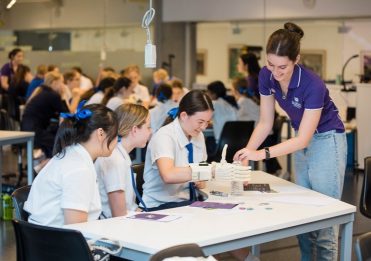Everything comes in cycles. The old becomes new and the new becomes old. Education in Queensland is currently experiencing such a reboot. After leading the world with the idea of internal school-based assessment, a new hybrid has emerged combining aspects of internal criteria-based assessment with the notion of subject-specific external examination. In many respects this is a welcome change but as with all change, great care must be taken to ensure that what is good and worthy is not jettisoned without great thought and due diligence.
Our approach at Girls Grammar has been to devise a School Wide Pedagogy model as a means by which to position the School well for this new environment. Harvard University’s Cultures of Thinking methodology, emanating from their long running Project Zeroresearch project, is informing our thinking. Cultures of Thinking focusses on making classroom thinking more visible, requiring teachers to reflectively tweak their existing practice. In a time-poor environment, especially one facing significant systemic change, such an approach is particularly welcome. As Dr Ron Ritchhart, Principal Investigator for Harvard Project Zero notes:
A school that embraces a culture of thinking is one where a group’s collective as well as individual thinking is valued, visible, and actively promoted as part of the regular, day-to-day experience of all group members. (Harvard, 2018)
The classroom, under this construct, becomes an even more vibrant culture where knowledge is learned and shared but also more importantly, created. When reflecting on the significance of Cultures of Thinking on her classroom practice, Ms Susan Garson, our Director of International Studies, has noted:
Cultures of Thinking reimagines classrooms as sites where thinking is more visible. Teachers are influential in facilitating learning and creating a culture in their classroom where students think for themselves, have the intellectual curiosity to disagree and are engaged in critical thinking, exploration and reflection. An understanding of these broader dispositions and strategies helps to create a culture of deep and visible learning. Such an approach forms the very kernel of Cultures of Thinking as well as formalising many of the processes and practices of good teaching and learning. (Brisbane Girls Grammar School, 2018)
To me such a celebration of teaching lies at the heart of relational pedagogy. A Cultures of Thinking approach rests very comfortably with the teacher as expert as well as the teacher as a co-sojourner in knowledge creation. Queensland University of Technology’s Professor Erica McWilliam (2009) has written extensively about the concept of teachers having to move from ‘sages on the stage’ to ‘guides on the side’ to ‘meddlers in the middle’. This works well if it is conceived relationally and not linearly.
The sage-like teacher must role-model discernment as a means of decoding information overload, and so often misinformation. Young people want to learn from experts and people who ‘know’—this should never be forgotten. The ‘guide on the side’ must be more than a ‘put them in front of a computer and research’ mindset.
An effective ‘guide on the side’ must know how to funnel the information ether back to their students, rather than allowing them to wallow in the dark matter of cyber space. Meddling in the middle is a space particularly suited to a Cultures of Thinking classroom. We must know what questions to ask and indeed what not to ask. We must be prepared to say what we don’t know but have the skills and interest to inquire (Addison, 2015).
In a world of enormous change, focussing on a methodology such as Cultures of Thinking that has ‘See – Think – Wonder’ at its basic core is a gift. It is a gift to the individual, to the collective and to civility. Imminent systemic change has given us an opportunity to examine and to re-examine. It has provided a window through which to think very carefully about our classroom practice. It has also gifted us a wonderful opportunity to reflect on the very rich domain that is relational pedagogy. As Parker Palmer has noted:
… my gift as a teacher is the ability to dance with my students, to co-create with them in a context in which all of us can teach and learn and…this gift works as long as I stay open and trusting and hopeful about who my students are. (2007, p. 75)
In such an environment, the old and the new can meld creatively, providing an opportunity for our students to greet tomorrow with confidence.
References
Addison, B. (2015). Schools as homes for the mind: pedagogy and the teacher as sage, guide and meddler. Australian Educational Leader, 37(3), 70–71.
Garson, S. (2018). Cultures of Thinking Action Research Group. Brisbane: Brisbane Girls Grammar School.
Harvard University (2018). Project Zero – Cultures of Thinking. Retrieved from http://www.pz.harvard.edu/projects/cultures-of-thinking
McWilliam, E. (2009). Teaching for creativity: From sage to guide to meddler. Asia Pacific Journal of Education, 29(3), 281–93.
Palmer, P. (2007). The courage to teach: Exploring the inner life of teachers. San Francisco: Josey-Bass




